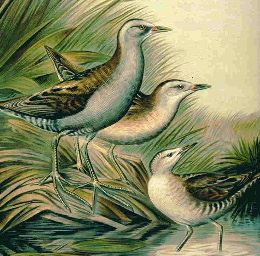- Little Crake
Taxobox
name = Little Crake
status = LC | status_system = IUCN3.1

image_width = 200px
regnum =Animal ia
phylum = Chordata
classis = Aves
ordo =Gruiformes
familia =Rallidae
genus = "Porzana "
species = "P. parva"
binomial = "Porzana parva"
binomial_authority = (Scopoli, 1769)The Little Crake ("Porzana parva") is a very small waterbird of the family
Rallidae .Their breeding habitat is
reed bed s inEurope , mainly in the east, and just into westernAsia . They nest in a dry location in reed vegetation, laying 4-7 eggs. This species is migratory, wintering inAfrica .At 17-19 cm length, they are slightly smaller than
Spotted Crake s, from which they are readily distinguished by the lack of dark barring and white spots on the flanks. They are more similar toBaillon's Crake .The Little Crake has a short straight bill, yellow with a red base. Adult males have mainly brown upperparts and blue-grey face and underparts. They have green legs with long toes, and a short tail which is barred black and white underneath.
Females have buff underparts, and are grey only on the face. Immature Little Crakes are similar to the female but have a white face and breast. The downy chicks are black, as with all rails.
These birds probe with their bill in mud or shallow water, also picking up food by sight. They mainly eat
insect s and aquatic animals.Little Crakes are very secretive in the breeding season, and are then mostly heard rather than seen. They are then noisy
bird s, with a yapping "kua" call. They can be easier to see on migration.The Little Crake is one of the species to which the "Agreement on the Conservation of African-Eurasian Migratory Waterbirds" (
AEWA ) applies.References
* Database entry includes justification for why this species is of least concern
Wikimedia Foundation. 2010.
